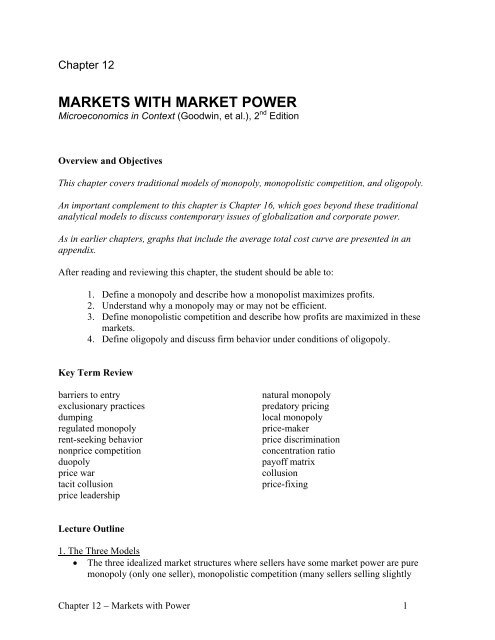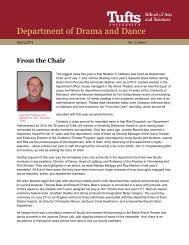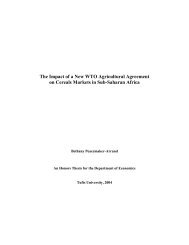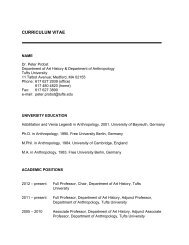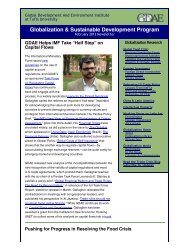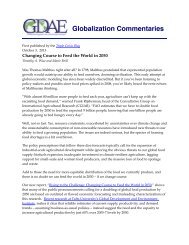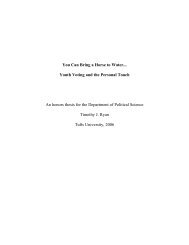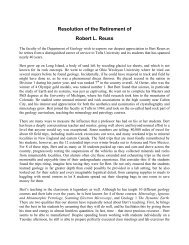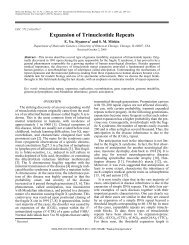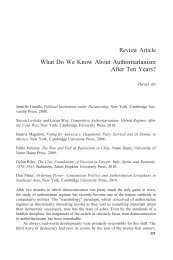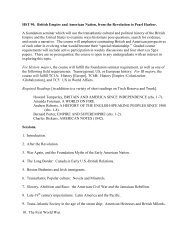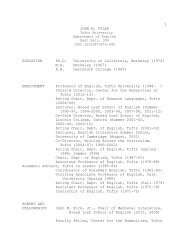MARKETS WITH MARKET POWER - Tufts University
MARKETS WITH MARKET POWER - Tufts University
MARKETS WITH MARKET POWER - Tufts University
You also want an ePaper? Increase the reach of your titles
YUMPU automatically turns print PDFs into web optimized ePapers that Google loves.
Chapter 12<br />
<strong><strong>MARKET</strong>S</strong> <strong>WITH</strong> <strong>MARKET</strong> <strong>POWER</strong><br />
Microeconomics in Context (Goodwin, et al.), 2 nd Edition<br />
Overview and Objectives<br />
This chapter covers traditional models of monopoly, monopolistic competition, and oligopoly.<br />
An important complement to this chapter is Chapter 16, which goes beyond these traditional<br />
analytical models to discuss contemporary issues of globalization and corporate power.<br />
As in earlier chapters, graphs that include the average total cost curve are presented in an<br />
appendix.<br />
After reading and reviewing this chapter, the student should be able to:<br />
1. Define a monopoly and describe how a monopolist maximizes profits.<br />
2. Understand why a monopoly may or may not be efficient.<br />
3. Define monopolistic competition and describe how profits are maximized in these<br />
markets.<br />
4. Define oligopoly and discuss firm behavior under conditions of oligopoly.<br />
Key Term Review<br />
barriers to entry<br />
exclusionary practices<br />
dumping<br />
regulated monopoly<br />
rent-seeking behavior<br />
nonprice competition<br />
duopoly<br />
price war<br />
tacit collusion<br />
price leadership<br />
natural monopoly<br />
predatory pricing<br />
local monopoly<br />
price-maker<br />
price discrimination<br />
concentration ratio<br />
payoff matrix<br />
collusion<br />
price-fixing<br />
Lecture Outline<br />
1. The Three Models<br />
• The three idealized market structures where sellers have some market power are pure<br />
monopoly (only one seller), monopolistic competition (many sellers selling slightly<br />
Chapter 12 − Markets with Power 1
different things), and oligopoly (so few sellers that each needs to watch what the others<br />
are doing).<br />
• The cases of monopoly and monopolistic competition can be analyzed using the<br />
traditional economic model. That model is not applicable to oligopoly because oligopoly<br />
markets are evolving social institutions.<br />
Teaching strategy: See the Extension “Competition and Concentration” (below) for more<br />
discussion of how these two forces interact, and why competition does not always win out.<br />
2. Pure Monopoly: One Seller<br />
2.1 The Conditions of Monopoly<br />
• The three conditions of monopoly are: only one seller, the good being sold has no close<br />
substitutes, and barriers exist to prevent new firms from entering the market.<br />
• One reason new firms may be prevented from entering monopoly markets is economic.<br />
The fixed costs to enter the market may be very high. A natural monopoly means that the<br />
minimum efficient scale of production is large relative to the market demand.<br />
• Barriers to entry may also be legal, such as through copyrights, patents, and trademarks.<br />
• Barriers to entry may also be deliberate. Through exclusionary practices a firm may get<br />
its suppliers to agree to not sell to competitors. Through predatory pricing a firm may<br />
temporarily sell at a price below its costs to drive competitors out of business.<br />
2.2 Examples of Monopoly<br />
• Examples of local monopolies (limited to a specific geographical region) are relatively<br />
common, such as the only theatre in a small town.<br />
• A regulated monopoly is a private company that is run under government supervision,<br />
such as AT&T in the past.<br />
2.3 Profit Maximization for a Monopolist<br />
• A monopolist will choose to produce where marginal cost equals marginal revenue.<br />
• Unlike a firm in a perfectly competitive market, a monopolist faces the entire demand<br />
curve and can adjust its selling price.<br />
• As a price-maker, a monopolist faces a downward-sloping marginal revenue curve.<br />
• Rather than setting price equal to marginal cost, a monopolist will set price at the<br />
maximum willingness to pay (the point on the demand curve).<br />
• A monopolist can make a sustained economic profit because new firms cannot enter the<br />
market to drive down prices.<br />
Teaching strategy: See the Extensions section (below) for additional numerical examples.<br />
2.4 Monopoly and Inefficiency<br />
• A deadweight loss exists in a monopoly market. Because the monopolist produces at an<br />
output level at which price exceeds marginal cost, society could gain from increased<br />
output of the product.<br />
• Graphical analysis illustrates that a monopoly market, as compared to the case of perfect<br />
competition, results in a transfer of benefits from consumers to the monopolist, as well as<br />
a deadweight loss.<br />
Chapter 12 − Markets with Power 2
• Monopolists may also use their market power to create other inefficiencies, such as<br />
engaging in rent-seeking behavior to obtain transfers or favors.<br />
2.5 Can Monopoly be Efficient?<br />
• In the case of a natural monopoly, multiple firms would have higher per-unit production<br />
costs than a monopolist. A firm operating under conditions of natural monopoly is<br />
normally regulated to produce at higher levels and sell at a lower price than the firm<br />
would on its own.<br />
• The granting of a monopoly through copyrights and patents can be a way to encourage<br />
research and innovation.<br />
• Monopolists may behave more like a competitive firm if they fear potential competitors<br />
or government regulation.<br />
• In the case of price discrimination, a firm can sell its product to different buyers at<br />
different prices. Buyers that are less responsive to price are charged a higher price. This<br />
allows the firm to capture more of potential consumer surplus as profits.<br />
3. Monopolist Competition<br />
3.1 The Conditions of Monopolist Competition<br />
• The four conditions of monopolistic competition are: numerous small buyers and sellers,<br />
the sellers produce goods that are similar but differentiated, producers can freely enter or<br />
exit the market, and buyers and sellers have perfect information.<br />
3.2 Examples of Monopolistic Competition<br />
• Examples of monopolistic competition are very common, such as fast-food restaurants<br />
and different types of bookstores.<br />
3.3 Profit Maximization with Monopolistic Competition<br />
• Monopolistically competitive firms face a downward-sloping demand curve. Their<br />
marginal revenue curve will lie below their demand curve.<br />
• Profit maximization occurs at the point where marginal revenue equals marginal cost.<br />
• If monopolistically competitive firms are making positive economic profits, then new<br />
firms will enter the market. This will increase supply, drive down prices, and eventually<br />
result in all firms earning zero economic profits.<br />
3.4 Monopolistic Competition and Long-Run Efficiency<br />
• Monopolistically competitive firms produce below the level where the social benefits of<br />
production are equal to the social costs. Thus, they operate inefficiently.<br />
• Monopolistically competitive firms may engage in non-price competition, such as<br />
through advertising or being open for long hours.<br />
4. Oligopoly<br />
4.1 The Conditions of Oligopoly<br />
• Oligopoly markets are characterized by containing only a few sellers (at least some of<br />
which are large enough to influence the market price); and conditions exist which make<br />
entry into such market difficult.<br />
• In making decisions, an oligopolist must anticipate the likely reaction of its rivals.<br />
Chapter 12 − Markets with Power 3
4.2 Examples of Oligopoly<br />
• Automobile manufacturing is a classic example of an oligopoly. There are only a handful<br />
of major automobile manufacturers.<br />
• The concentration ratio is the proportion of total market sales that go to the largest firms<br />
in the industry. The concentration ratio for the four largest firms in some oligopoly<br />
markets is above 0.80.<br />
4.3 Oligopoly and the Behavior of Firms<br />
• One model for analyzing the behavior of oligopolists is game theory, where firms plot<br />
their moves as if engaged in a competitive game.<br />
• A payoff matrix shows the benefits of one seller as a function of the behavior of another<br />
seller. While each firm would benefit by selling at a lower price than its competitor, if<br />
they engage in a price war they will both end up making relatively low profits.<br />
• A payoff matrix illustrates that two such firms could do better if they were able to<br />
cooperate. Through collusion, the firms could both agree not to lower their prices.<br />
Collusion is difficult to sustain because each firm has an incentive to lower its prices and,<br />
at least temporarily, increase its own profits.<br />
Teaching Strategy: The analysis of oligopoly in the text is mostly static. You might want to<br />
discuss that oligopoly and payoff matrices are dynamic. If one firm gains a temporary<br />
advantage, the other will likely respond quickly by cutting its own price. Thus, the<br />
cooperative equilibrium is very unstable. It is like being on the top of a steep hill – a small<br />
move away from the top can result in a big fall. If one firm “cheats,” it may be able to<br />
cooperate again but the other firm will likely be very suspicious.<br />
Teaching Strategy: See the Extensions section (below) for two in-class “games” illustrating<br />
the behavior of cartels.<br />
4.4 Is Oligopoly Rampant?<br />
• The key feature of oligopoly is the degree of interdependence among the firms. In<br />
reality, most any real-world firm will consider the actions of its rivals. A more complete<br />
analysis of oligopoly must consider more than just economic factors – it must also<br />
consider social factors in the firms’ response.<br />
5. Summary and a Final Note<br />
• In the real world, markets may not easily be categorized into just one of the four basic<br />
structures.<br />
• Arguments in favor of “free” markets rely on the perfectly competitive model which<br />
maximizes efficiency. But examples of markets with some degree of market power are<br />
much more common than markets with perfect competition.<br />
Appendix: A Formal Analysis of Market Structures with Market Power<br />
• The profit levels achieved by monopolists and by firms in monopolistic competition can<br />
be illustrated using the demand, MC, MR and ATC curves.<br />
Chapter 12 − Markets with Power 4
Notes on Text Discussion Questions<br />
2.1. This would represent a case of a local monopoly because students could still travel to a<br />
different university bookstore to buy their books. However, they would most likely find that<br />
the prices of books across different university bookstores are very similar. You might ask<br />
them why several university bookstores in a small geographical area (such as when several<br />
colleges are found in a metropolitan area) all have similar prices, when one bookstore could<br />
potentially capture a large share of the market by lowering their prices. This could<br />
foreshadow the discussion of oligopoly later in the chapter. Most students will be aware of<br />
some alternatives to buying textbooks at their college bookstore, such as a student-run<br />
cooperative or the Internet. Still, these alternatives haven’t driven down the price of texts at<br />
university bookstores much, if at all. Perceptive students might realize that monopoly power<br />
also resides with publishers who set prices for their books and continually revise books to<br />
limit the impact of the used book market. They may also note that professors, who don’t<br />
have to pay for their books, have little incentive to try to reduce students’ book costs by<br />
possibly using older editions or encouraging students to share books.<br />
2.2. This question should help reinforce the efficiency/inefficiency issues related to monopolies.<br />
Having just one company make all electronic goods would clearly improve compatibility.<br />
Other potential benefits include greater availability of repair choices and lower production<br />
costs through economies of scale. But there would be several disadvantages of having just<br />
one electronics company, including the potential for higher monopoly prices, reduced<br />
innovation, and fewer consumer choices. If students believe that having just one company is<br />
a good idea, you can ask them why this hasn’t happened. Electronics is not an industry<br />
where market forces have produced a natural monopoly. A discussion about why this is not<br />
the case can focus on production costs, consumer preferences, and innovation.<br />
3.1. This question is best used for discussion, where students could compare the prices they pay<br />
for certain goods. Coffee is a good that likely varies significantly in price across firms.<br />
While some of the difference can be attributed to quality differences, ask students to consider<br />
other differences as well (convenience, status, atmosphere, etc.). Gas, on the other hand, is a<br />
good that varies less in quality. Ask students why gas prices often vary in a region and why<br />
everyone doesn’t simply buy gas from the cheapest station in the area. Note that, even after<br />
considering many factors, some slight differences in price might remain puzzling. This could<br />
be explained by using the “thick curves” that were described in the Extension to Chapter 4<br />
notes in the IRM, where equilibrium is represented by a range of outcomes rather than a<br />
single point.<br />
3.2. Students are most likely faced with a tremendous variety of goods and services. Hopefully,<br />
an interesting discussion could be structured around whether this variety is “too much.” For<br />
example, would five brands of toothpaste be enough for society or is society better off with<br />
fifteen choices? Ask students to consider the resources devoted to developing and promoting<br />
many different brands, and the benefits consumers receive from additional choices. Some<br />
students might offer a situation of declining marginal benefits – the first few choices<br />
significantly benefit consumers but eventually more choices yield few benefits. Non-price<br />
competition can provide consumers with benefits such as improved quality, greater<br />
Chapter 12 − Markets with Power 5
convenience, etc., but it can also reduce social well-being. Students should recognize that<br />
advertising can impose costs on society by increasing prices, encouraging irresponsible<br />
spending, and targeting children. Some non-price competition, such as disposable products<br />
and single-serve portions can increase environmental impacts.<br />
4.1. a) In a prisoner’s dilemma situation, each firm would benefit from having the lower price.<br />
However, with both firms taking a low-price strategy and no cooperation, neither firm will<br />
gain a price advantage. The result will likely be lower profits for both due to a price war.<br />
b) If the two firms collude to set price, they can both maintain high profits. Note, however,<br />
that each firm also has an incentive to lower price and capture a larger market share and<br />
higher profits.<br />
4.2. The payoff matrix with revised labels is given below. The “Low Price” labels are replaced<br />
with “Spend a lot” and “High Price” is replaced with “Spend a little.” Firms undertake<br />
advertising because they want to increase sales and revenues (and raise profits), but<br />
advertising also costs money (an expense which reduces profits). In this case, each firm<br />
perceives a benefit from a lot of advertising because, if its rival doesn’t advertise as much, it<br />
will be able to steal the other’s customers and make high profits. If one chooses not to spend<br />
much while its rival spends a lot, the situation is reversed, and the first firm will make losses.<br />
However, if both spend a lot, they have to split the customer base while having high<br />
expenses, yielding low profits. If both spend only a little, they will again split the customer<br />
base, but their expenses (for ads that essentially cancel each other out) aren’t as high, so their<br />
profits will be moderate. Each one will realize that the worst they can do if they spend a lot is<br />
get a low profit, while if they only spend a little they could end up making losses. As a<br />
result, the noncooperative outcome is for both firms to spend a lot of money on advertising,<br />
and make low profits (the upper left cell in the figure below). If advertising were severely<br />
limited by law, each firm would save on ineffective advertising costs and the moderate profit<br />
(lower right cell) payoff could be reached instead. Thus, the companies’ profits would<br />
increase if they are both forced to cut back. While the government has limited advertising of<br />
cigarettes and alcohol for public health reasons, this could have the somewhat perverse result<br />
of increasing profits to the cigarette and alcohol manufacturers!<br />
Firm 2’s Options<br />
Firm 1’s Options<br />
Spend a<br />
lot<br />
Spend a<br />
little<br />
Spend a lot<br />
low profit<br />
low profit<br />
high profit<br />
loss<br />
Spend a little<br />
loss<br />
high profit<br />
moderate profit<br />
moderate profit<br />
5.1. Recall from Chapter 5 that Braeburn does have a monopoly on the particular book of<br />
poetry they are selling, but they compete with many other publishing firms. Thus, the market<br />
structure of monopolistic competition corresponds most with Braeburn’s position. As they<br />
increase the price of the book, they will lose some (but not all) customers. Braeburn will<br />
Chapter 12 − Markets with Power 6
most likely engage in non-price competition to differentiate themselves from other<br />
publishers. They may advertise to specific markets, sponsor books signings, and use other<br />
tactics to promote their books.<br />
5.2. This question is designed to tap into the real-world knowledge that some students might<br />
have about market structure. It may be best run as a full-class exercise, taking the<br />
experience of one or a few students, and having a full-class discussion of each case.<br />
Students should be encouraged not just to tell stories, but rather use the stories to unravel<br />
and illustrate (and even critique) the “conditions” for the various market structures<br />
described in the text. For less experienced classes, you might substitute a general call for<br />
examples, with an example of your own of a well-known consumer-good manufacturer that<br />
has been in the news.<br />
Answers to End-of-Chapter Review Questions<br />
1. The three idealized market structures with market power are: pure monopoly (only one<br />
seller), monopolistic competition (many sellers, but they sell slightly different things),<br />
and oligopoly (so few sellers that they each need to watch what the others are doing).<br />
2. Pure monopoly is characterized by: only one seller, the good being sold has no close<br />
substitutes, and barriers of entry exist.<br />
3. Three types of barriers to entry are: economic barriers (high fixed costs, network<br />
externalities, economies of scale), legal barriers (copyrights, franchises, patents,<br />
trademarks), and deliberate barriers (exclusionary practices, predatory pricing, dumping).<br />
4. A pure monopolist is imagined to maximize profits by producing where marginal revenue<br />
equals marginal cost but charging as high a price as it can on the market demand curve.<br />
5. Monopolists are inefficient because: deadweight loss is created (the price level exceeds<br />
marginal cost), innovations may be reduced, costs may be spent to maintain barriers to<br />
entry, and rent-seeking behavior.<br />
6. Monopoly market power generally leads to inefficiencies in the form of deadweight loss.<br />
The monopolist produces at an output level at which price exceeds marginal cost and<br />
society could gain from increased output of the product. See Figure 12.2.<br />
7. Four cases in which a monopoly might be efficient are: natural monopolies (economies of<br />
scale dictate that one firm can produce at the minimum per-unit cost), intellectual<br />
property (the potential benefits of patents, trademarks, etc. actually encourage<br />
innovations), pressure to appear competitive (firms worry that too-high monopoly profits<br />
will attract too much attention so they operate more like a competitive firm), and perfect<br />
price discrimination (the monopolist is able to charge every buyer his or her maximum<br />
willingness to pay).<br />
Chapter 12 − Markets with Power 7
8. A price-discriminating seller charges different prices to different buyers, reducing or<br />
eliminating consumer surplus. See Figure 12.3.<br />
9. Monopolistic competition is characterized by: numerous small buyers and sellers, each<br />
seller’s product is somewhat different from that offered by the other sellers, producers of<br />
the good or service can freely enter or exit the industry, and buyers and sellers have<br />
perfect information.<br />
10. A monopolistically competitive firm is expected to maximize profits by producing where<br />
marginal revenue equals marginal cost, charging a price set by the demand curve for its<br />
product, and trying to engage in non-price competition.<br />
11. Monopolistically competitive markets are not efficient because firms, compared to<br />
perfectly competitive firms, will produce lower levels of output and charge higher prices.<br />
12. Oligopoly is characterized by a market dominated by only a few sellers and difficult<br />
entry.<br />
13. Two theories used to describe the behavior of oligopolists are: strategic interaction and<br />
game theory (firms plot their moves while considering other firms’ behavior), and<br />
collusion, cartels and price leadership (firms cooperate and form a monopoly for pricing<br />
purposes).<br />
Answers to End-of-Chapter Exercises<br />
1. a) The demand curve is given below.<br />
b) The completed cost table is given below. See the graph above for the marginal revenue<br />
curve.<br />
Chapter 12 − Markets with Power 8
Quantity of Output<br />
(Demanded)<br />
Selling Price<br />
($)<br />
Total Revenue<br />
($)<br />
Marginal Revenue<br />
($)<br />
1 17 17 17<br />
2 14 28 11<br />
3 11 33 5<br />
4 8 32 -1<br />
5 5 25 -7<br />
c) The selling price of $8 cannot be profit maximizing because the marginal revenue is<br />
negative – Braeburn decreases its revenue by producing and selling the fourth book.<br />
d) See the graph above for the horizontal marginal cost curve.<br />
e) Profit maximization occurs where marginal revenue equals marginal cost. In the graph<br />
above, this occurs at a production level of three books and a price of $11.<br />
f) At a price of $8, Braeburn would sell four books for a total revenue of $32. Total cost<br />
would be $20 (4*$5) and profits would be $12. At the profit maximizing price of $11,<br />
Braeburn’s revenues are $33, their costs are $15, and their profits are $18.<br />
2. a) Firm 1 will make high (additional) profit; Firm 2 will make no (additional) profit--as<br />
shown in the upper right cell in the payoff matrix.<br />
b) The worst that can happen to Firm 1 if it opens a new outlet is that it could make moderate<br />
profit. If it doesn’t open one, the worst that can happen is that it could make no profit. So it<br />
will open the new outlet.<br />
c) The outcome will be that each firm will open a new outlet. The end result will be that each<br />
firm will make a moderate profit.<br />
d) This situation is not like the prisoner’s dilemma because the firms could not both clearly<br />
achieve a better outcome through cooperation.<br />
e) Given the potential to open outlets in multiple towns, the firms do have potential gains<br />
through collusion. Suppose there are two potential towns. If both firms open an outlet in<br />
each town, each firm will make only a moderate profit in each town. However, if one firm<br />
opens an exclusive outlet in one town and the other firm opens an exclusive outlet in the<br />
other town, each firm would make a high profit. Thus (if “high” is greater than two<br />
“moderates”) an agreement that gives each firm exclusive access to each town has the<br />
potential to benefit both firms.<br />
3. The correct matches are a-2, b-5, c-1, d-7, e-4, f-6, g-3.<br />
Extensions<br />
1. Discussion of “Competition and Concentration” (suitable for lecture preparation or handout).<br />
(1 page)<br />
2. Extra numerical example of Monopoly. NOTE: Table 1 refers only to material covered in the<br />
text, but uses the notation “Δ” for “change in.” Table 2 includes material (average variable costs<br />
and average total costs) covered in the appendix, and also includes average fixed costs (not<br />
Chapter 12 − Markets with Power 9
covered in the appendix). Table 2 and the graph use the notation “AR=Demand” which is not<br />
used in the text. (3 pages)<br />
3. Extra exercise on “Monopoly Profit-Maximization” (suitable for in-class use or homework).<br />
and answer key. NOTE: The calculation of profit involves material covered in the appendix. (2<br />
pages)<br />
4. Question on Monopoly Profit Maximization, suitable for use on an exam, and answer key.<br />
NOTE: The calculation of profit involves material covered in the appendix. (1 page)<br />
5. A handout on the “Cartel Game” and answer sheet NOTE: THIS EXERCISE HAS BEEN<br />
WRITTEN FOR A CLASS OF 36 STUDENTS. (3 pages)<br />
6. Handout on the “Grading Game” (1 page)<br />
Chapter 12 − Markets with Power 10
Competition and Concentration<br />
There is a perpetual struggle between the forces of competition and the forces that tend toward<br />
concentration. (This will be discussed further in Chapter 16.) In one sense almost everyone is<br />
engaged in a “pan-human conspiracy” against competition: firm owners and managers don’t like<br />
it because it reduces profits, while workers don’t like it because firms that are being squeezed by<br />
competition become cost-cutters – and that usually includes making life less pleasant for the<br />
workers: faster pace of work, more supervision, and often reduced benefits, even reduced pay.<br />
(We have seen a great deal of this in the last decade, as global competition made more firms<br />
more “lean and mean.”) Most people, during most of their lives, share this<br />
owner/manager/worker point of view. At the same time, everyone is a consumer – and it’s<br />
consumers (and economists) who see competition as highly desirable, precisely because it gets<br />
firms to lower the prices of their products (which is why they are obliged to lower production<br />
costs.)<br />
Note that the advantages of bigness do not always produce high concentration, or allow firms to<br />
escape from the whip of competition. If the market for the product is large enough, or is growing<br />
fast enough, it may not produce monopoly or oligopoly. The monopolizing trend is most likely<br />
to win over the forces of competition when the market is not too big to overwhelm the<br />
advantages of large firm size.<br />
In any case, competition is not a stable situation: when it heats up, it tends to lead to shake-outs<br />
that encourage bigness and monopoly. That’s part of the explanation for the confusing picture<br />
we see when we look at global markets today. Competition seems to be increasing in many<br />
ways, as virtually all firms are competing against producers throughout the whole world; yet, at<br />
the same time, many firms have attained such enormous size that they have achieved significant<br />
power, even in the global market.<br />
Why and how do they attain such power? First of all, the motivations to escape the constraints<br />
of severe competition are very strong; corporate leaders work extremely hard, and can employ<br />
teams of very able people to help them, to figure out strategies that will give them market power.<br />
Given these strong motivations, corporate leaders also reach out to government officials who can<br />
help them, as well as to international bodies. While we see the big firms competing against one<br />
another for customers, at another level they recognize, and act on, a joint interest in reducing<br />
competition, and are often able to create and maintain local, national and international laws and<br />
regulations that can give them special advantages, or protections against would-be competitors or<br />
against constraints on their growth.<br />
Chapter 12 − Markets with Power 11
Monopoly<br />
Table 1:<br />
The Monopoly’s Demand Curve & its Total Revenue<br />
the demand curve:<br />
average<br />
revenue = price<br />
at each<br />
quantity ($/bu)<br />
q<br />
quantity<br />
of<br />
output<br />
total revenue (TR) =<br />
p×q<br />
marginal<br />
revenue<br />
ΔTR/Δq<br />
(bu) ($) ($/bu)<br />
AR = P q TR MR<br />
23 5 115 23<br />
22 10 220 21<br />
21 15 315 19<br />
20 20 400 17<br />
19 25 475 15<br />
18 30 540 13<br />
17 35 595 11<br />
16 40 640 9<br />
15 45 675 7<br />
14 50 700 5<br />
13 55 715 3<br />
12 60 720 1<br />
11 65 715 -1<br />
10 70 700 -3<br />
9 75 675 -5<br />
8 80 640 -7<br />
7 85 595 -9<br />
6 90 540 -11<br />
5 95 475 -13<br />
4 100 400 -15<br />
3 105 315 -17<br />
elastic demand: TR rises as P falls.<br />
inelastic demand: TR<br />
falls as P falls.<br />
Chapter 12 − Markets with Power 12
Table 2:<br />
Production and Costs under Monopoly.<br />
The New Example: continued.<br />
Fixed<br />
Cost =<br />
quantity<br />
of<br />
output<br />
60 price varies with quantity profit schedule<br />
average cost schedule<br />
demand<br />
curve: the<br />
price at<br />
average<br />
fixed<br />
costs<br />
average average<br />
variable total<br />
costs costs<br />
Marginal<br />
Cost<br />
ΔTC/Δq<br />
(bu) ($/bu) ($/bu) ($/bu) ($/bu)<br />
each<br />
quantity<br />
produced.<br />
total<br />
revenue =<br />
p×q<br />
marginal<br />
revenue<br />
= ΔTR/Δq<br />
Total<br />
profit =<br />
(TR–TC)<br />
extra<br />
profit =<br />
(MR –<br />
MC)<br />
($/bu) ($) ($/bu) ($) ($/bu)<br />
q AFC AVC ATC MC AR TR MR<br />
5 12.000 0.800 12.800 0.8 23 115 23 51 22.20<br />
10 6.000 0.600 6.600 0.4 22 220 21 154 20.60<br />
15 4.000 0.600 4.600 0.6 21 315 19 246 18.40<br />
20 3.000 0.750 3.750 1.2 20 400 17 325 15.80<br />
25 2.400 0.920 3.320 1.6 19 475 15 392 13.40<br />
30 2.000 1.100 3.100 2.0 18 540 13 447 11.00<br />
35 1.714 1.286 3.000 2.4 17 595 11 490 8.60<br />
40 1.500 1.475 2.975 2.8 16 640 9 521 6.20<br />
45 1.333 1.667 3.000 3.2 15 675 7 540 3.80<br />
50 1.200 1.860 3.060 3.6 14 700 5 547 1.40<br />
55 1.091 2.055 3.145 4.0 13 715 3 542 -1.00<br />
60 1.000 2.250 3.250 4.4 12 720 1 525 -3.40<br />
65 0.923 2.446 3.369 4.8 11 715 -1 496 -5.80<br />
70 0.857 2.643 3.500 5.2 10 700 -3 455 -8.20<br />
Chapter 12 − Markets with Power 13
Chapter 12 − Markets with Power 14
Exercise on Monopoly Profit-Maximization<br />
Before World War II, the Alcoa corporation had a monopoly in the production of aluminum. Assume that its demand<br />
and cost data are as follows:<br />
demand curve<br />
quantity, q<br />
average<br />
total cost,<br />
ATC<br />
price, p<br />
11 93 10<br />
12 91 11<br />
13 89 13<br />
14 87 15<br />
15 85 17<br />
16 83 20<br />
17 81 24<br />
18 79 28<br />
A) Use the numbers above to fill in the following table:<br />
quantity, q<br />
total<br />
revenue, TR<br />
marginal<br />
revenue,<br />
MR<br />
marginal<br />
cost, MC<br />
total cost,<br />
TC total profit<br />
11 _______ _______ _______ _______ _______<br />
12 _______ _______ _______ _______ _______<br />
13 _______ _______ _______ _______ _______<br />
14 _______ _______ _______ _______ _______<br />
15 _______ _______ _______ _______ _______<br />
16 _______ _______ _______ _______ _______<br />
17 _______ _______ _______ _______ _______<br />
18 _______ _______ _______ _______ _______<br />
B) What is the profit-maximizing level of output? ____________________<br />
C) What is the profit-maximizing price? ________________________<br />
D) Given the average total cost data, what profit is Alcoa making per unit of output?________<br />
E) Assume that Alcoa acted as if it were perfectly competitive, setting price equal to MC, where<br />
the price is determined by the demand curve. Then its short-run profit-maximizing output level = _______<br />
F) In this case, its short-run profit-maximizing price = _______________<br />
G) What would be the profits per unit of Alcoa in this case? ____________<br />
H) Which is more profitable to Alcoa, to act as a competitive firm or as a monopolist?<br />
Chapter 12 − Markets with Power 15
Exercise on Monopoly Profit-Maximization—Answer Key<br />
Before World War II, the Alcoa corporation had a monopoly in the production of aluminum. Assume that<br />
its demand and cost data are as follows:<br />
demand curve average total<br />
quantity price cost<br />
11 93 10<br />
12 91 11<br />
13 89 13<br />
14 87 15<br />
15 85 17<br />
16 83 20<br />
17 81 24<br />
18 79 28<br />
quantity,<br />
q<br />
11<br />
12<br />
13<br />
14<br />
15<br />
16<br />
17<br />
18<br />
A) Use the numbers above to fill in the following table: I added a column at the left, to represent prices.<br />
from the<br />
demand<br />
curve:<br />
price<br />
total<br />
revenue,<br />
TR = p×q<br />
marginal<br />
revenue,<br />
MR =<br />
ΔTR/Δq<br />
marginal<br />
cost, MC<br />
= ΔTC/Δq<br />
total cost,<br />
TC =<br />
ATC×q<br />
profit =<br />
TR – TC<br />
93 1023 n.a. n.a. 110 913<br />
91 1092 69 22 132 960<br />
89 1157 65 37 169 988<br />
87 1218 61 41 210 1008<br />
85 1275 57 45 255 1020<br />
83 1328 53 65 320 1008<br />
81 1377 49 88 408 969<br />
79 1422 45 96 504 918<br />
B) What is the profit-maximizing level of output? 15 (as close to MR = MC as possible, but not too far).<br />
C) What is the profit-maximizing price? $85 (from the demand curve at q = 15).<br />
D) Given the average total cost data, what profit is Alcoa making per unit of output? P – AC = $85 - $17 = $68.<br />
E) Assume that Alcoa acted as if it were perfectly competitive, setting price equal to MC, where<br />
the price is determined by the demand curve. Then its short-run profit-maximizing output level = 16<br />
(this what we get if output is expanded as long as P > MC, to get as close as possible to P = MC without going too<br />
far.)<br />
F) If Alcoa acted as if it were perfectly competitive, its short-run profit-maximizing price = $83 (from the demand<br />
curve at P = 15)<br />
G) What would be the profits of Alcoa if it acts like a perfectly competitive firm? P – AC = $83 - $20 = $63 per<br />
unit or $1008 total.<br />
H) Which is more profitable to Alcoa, to act as a competitive firm or as a monopolist? It’s more profitable to<br />
act as a monopolist.<br />
Chapter 12 − Markets with Power 16
Question on Monopoly Profit Maximization<br />
The graph below represents the average total cost and marginal cost curves (ATC & MC), and the<br />
marginal revenue and demand curves (MR & D), for a monopoly, the BFC (the “Big Friggin’<br />
Company”). FIRST, fill in the blanks below to indicate the name of each of the curves. (If you want, you<br />
may use the initials.) THEN answer the questions below the graph.<br />
A.__________________<br />
B.__________________<br />
C.__________________<br />
D.__________________<br />
E. If BFC acts as a profit-seeking monopoly, it would produce a quantity of about_____________<br />
units per month, while the price would equal about ____________.<br />
F. Is the company making an economic profit in this situation? _____________.<br />
G. If the BFC is forced to act like a competitive firm, the quantity equals about ________<br />
units per month while the price would equal about ___________________.<br />
Question on Monopoly Profit Maximization—Answer Key<br />
A. MC B. D C. ATC D. MR<br />
E. If BFC acts as a profit-seeking monopoly, it would produce a quantity of about____13____<br />
units per month, while the price would equal about _____50_______.<br />
F. Is the company making an economic profit in this situation? Explain. ____Yes. At 13 units of output,<br />
each unit on average costs about $30 (see the ATC) to produce, which is less than the selling price of<br />
$50____.<br />
G. If the BFC is forced to act like a competitive firm, the quantity equals about ___17_____<br />
units per month while the price would equal about _________48__________.<br />
Chapter 12 − Markets with Power 17
The Cartel Game<br />
Each student in the class is the entrepreneur of a small firm producing widgets. Each firm has the<br />
same conditions of production:<br />
1. Each firm can choose to produce either 1 or 2 widgets per day. You must decide what level of<br />
output to produce in order to maximize your profits.<br />
2. The MC of producing a widget is $0.50 at all levels of output. This equals the AC (average or<br />
per-unit costs) of producing widgets.<br />
3. All of the firms earn the same price in selling widgets. The market price is set by the total of<br />
all the firms' outputs (the total amount supplied) and the market demand curve. The demand<br />
curve appears in the first two columns in the table on the next page.<br />
4. The third column in the table shows the marginal revenue curve that would be seen if all<br />
students united to form the Association of Widget Entrepreneurs (AWE), a cartel.<br />
A. If the cartel acts to maximize profits of the group, what level of output will be produced?<br />
B. What will the profits for all of the AWE be in this case? Are they AWEsome?<br />
C. If the profits are distributed equally among the firms, what will the profits be per firm?<br />
5. The government comes in and uses anti-trust laws to break up the AWE. Now each of you has<br />
to decide how much to produce. Remember that your goal is to maximize your own profits.<br />
We will play two rounds of the game, doing it two ways:<br />
A. in the first round, hold up your hand if you want to produce two widgets; don't hold up your<br />
hand if you want to produce one. (It’s not allowed for you to produce 0.)<br />
B. in the second round, write whether you want to produce 2 or 1 widgets on a piece of paper.<br />
Do not show the papers to other students.<br />
On each we can calculate the market price (given the demand curve) and your profits (your<br />
quantity*(p – AC)).<br />
Chapter 12 − Markets with Power 18
industry demand<br />
curve<br />
AWE's<br />
MR<br />
q p<br />
23 2.48 1.60<br />
24 2.44 1.52<br />
25 2.40 1.44<br />
26 2.36 1.36<br />
27 2.32 1.28<br />
28 2.28 1.20<br />
29 2.24 1.12<br />
30 2.20 1.04<br />
31 2.16 0.96<br />
32 2.12 0.88<br />
33 2.08 0.80<br />
34 2.04 0.72<br />
35 2.00 0.64<br />
36 1.96 0.56<br />
37 1.92 0.48<br />
38 1.88 0.40<br />
39 1.84 0.32<br />
40 1.80 0.24<br />
41 1.76 0.16<br />
42 1.72 0.08<br />
43 1.68 0.00<br />
44 1.64 -0.08<br />
45 1.60 -0.16<br />
q p<br />
AWE's<br />
MR<br />
45 1.60 -0.16<br />
46 1.56 -0.24<br />
47 1.52 -0.32<br />
48 1.48 -0.40<br />
49 1.44 -0.48<br />
50 1.40 -0.56<br />
51 1.36 -0.64<br />
52 1.32 -0.72<br />
53 1.28 -0.80<br />
54 1.24 -0.88<br />
55 1.20 -0.96<br />
56 1.16 -1.04<br />
57 1.12 -1.12<br />
58 1.08 -1.20<br />
59 1.04 -1.28<br />
60 1.00 -1.36<br />
61 0.96 -1.44<br />
62 0.92 -1.52<br />
63 0.88 -1.60<br />
64 0.84 -1.68<br />
65 0.80 -1.76<br />
66 0.76 -1.84<br />
67 0.72 -1.92<br />
68 0.68 -2.00<br />
69 0.64 -2.08<br />
70 0.60 -2.16<br />
71 0.56 -2.24<br />
72 0.52 -2.32<br />
73 0.48 -2.40<br />
Chapter 12 − Markets with Power 19
Answers to the Cartel Game (class of 36 students):<br />
4A: 36 (where MC ≈ MR, .50 ≈ .56)<br />
4B: 36 × ($1.96 − $.50) = $52.56<br />
4C: $ 52.56/36 = $1.46 (assuming each firm produces 1 unit)<br />
5: (Will students maintain implicit collusion, and make profits? Or will individuals, especially when anonymous,<br />
“defect” and produce 2 units, driving down the price? )<br />
Chapter 12 − Markets with Power 20
The Grading Game<br />
a) suppose that I graded using a hard-core curve. 1/10 of the students get an "A"; 2/10 get "B";<br />
4/10 get "C"; 2/10 get "D"; and 1/10 get "F"<br />
b) Suppose that one’s relative grade reflects both relative preexisting talent, luck, and relative<br />
effort.<br />
c) Since we don’t have any control over talent or luck, if people want higher grades, they need<br />
to work harder.<br />
d) the problem is that there’s a limited number of As and Bs, so that the students are all<br />
competing over them. If I work hard and move up to an A, then someone else is pushed<br />
down.<br />
e) thus, there's an incentive for the students to restrict their efforts. If everyone colludes to not<br />
work very hard, you'd still see pretty much the same distribution of grades as when<br />
everybody works hard. The benefit is that less effort is needed, though less economics is<br />
learned. If grades are all that's important to you, then the latter is unimportant.<br />
f) the problem of free riders can undermine the attainment of the collective good. These are<br />
students who either care about the grade enough that they are willing to take advantage of<br />
their fellow students by working more than agreed upon, in order to rise in the ranks. Or<br />
these students might really want to learn economics.<br />
g) a well-organized cartel of students could make sure that free riders don't cheat. They could<br />
throw big parties the night before the exam and make sure that everyone attends. Perhaps<br />
punish the ones who "free ride" on the rest.<br />
Chapter 12 − Markets with Power 21


